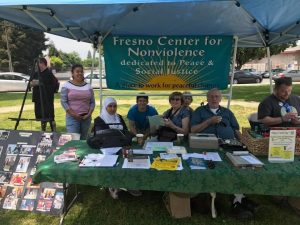
By Rita Bell:
Come out to Earth Day Fresno on Saturday, April 14 from 10:00 am to 4:00 pm at Radio Park, 2233 N. First Street in Fresno, 93703, where we can bring consciousness to our neighbors and encourage one another in our efforts to save our planet! The event will kick off with Native American flute opening ceremony. Live local entertainment, including McCoy Hip Hop Group, Cooper Folklorico Group, Tounkara Plus, and Clovis High Marimba Band will immediately follow and continue throughout the day. There will be a large Children’s area with games and activities focused on environmental awareness.
This year Earth Day Fresno is focused on the use of plastics and drawing awareness to the national End Plastic Pollution campaign. Many readers are already aware that plastic pollution is one of the most serious and dangerous problems we face in the near future.
Water bottles are the obvious evil culprit, but if we look around us, plastic is everywhere; literally at our fingertips, from our computer keyboards and monitors to cell phones, televisions, car parts, and cosmetic containers. Many American homes contain an amazing amount of single use plastic: straws, storage bags, bowls, plates and utensils, food packaging, cotton swabs with plastic sticks, toothbrushes, medicine bottles, cleaning bottles, laundry detergent bottles – I thought of these items just in the time it took me to write them out! Fifty percent of the plastic we use is used just once and thrown away. We might say, But, recycling! Unfortunately, we recover less than 10% of the plastics we produce. Recycling is very important, but it is not cutting it. In California, we have banned single use plastic bags and cities are required to have a recycling plan in place. Our efforts still aren’t enough, and, really, an item-by-item, city-by-city, state-by-state approach is just inadequate.
The first problem with all of our plastic use is that it takes 500-1,000 years for plastic to degrade. And we just don’t have the space for it. Enough plastic is thrown away each year to circle the earth four times. How long and where do we think we can continue to store it? Plastic is ending up in our oceans constituting approximately 90 percent of all trash floating on the ocean’s surface, with 46,000 pieces of plastic per square mile. This is damaging sea life with one million sea birds and 100,000 marine mammals being killed annually from plastic in our oceans. Plastic is also hurting humans. The University of Florida found that 93 percent of Americans age six or older test positive for BPA, a plastic chemical, so we know that plastic chemicals can be absorbed by our bodies. Some plastic chemical components have been found to alter hormones and other human health effects.
In addition to recycling, banning single use plastic items such as bags and straws, we must fund and support a nationwide information campaign similar to that of the harmful effects of tobacco and lead. With information, people can take action, demanding that manufacturers, product and service suppliers stop using plastic. With information comes awareness of the plastic items we rely on and knowledge of alternatives. For instance, in addition to eliminating single use of a large plastic container, it is cheaper and less harmful to make your own detergent. Instead of packing our lunch in single use plastic bags and containers, we can use reusable containers. Check out Earth Day Network’s plastic pollution primer at http://www.earthday.org/wp-content/uploads/Plastic-Pollution-Primer-and-Action-Toolkit.pdf full of information and a plastic consumption calculator, which can be a first step in awareness.


